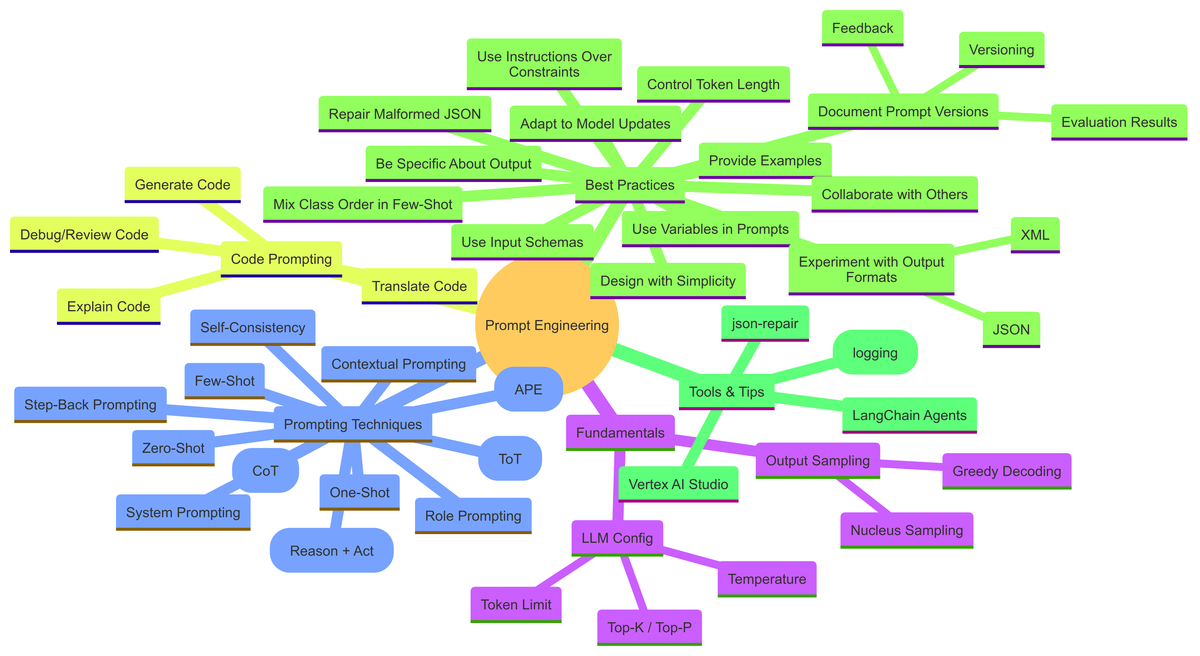In the age of generative AI, prompt writing has become a core engineering skill. Whether building a chatbot, generating code, or designing autonomous agents, the prompt is your most powerful interface with a Large Language Model (LLM).
This post distills the key ideas from Lee Boonstra’s excellent “Prompt Engineering” (Google Cloud) whitepaper, adding my structure and visuals to offer you a practical cheat sheet and mind map. It’s ideal for AI developers, product engineers, and anyone working with LLMs.
Prompt engineering isn’t just writing instructions — it’s an iterative, analytical, and creative process. Techniques like Chain of Thought, ReAct, or Step-Back Prompting push LLMs beyond surface-level output and unlock deeper reasoning, precision, and control.
The Cheatsheet
| Technique / Best Practice | Description | When to Use | Example |
|---|---|---|---|
| Zero-Shot Prompting | Directly instructs the model without examples. | Simple tasks, clear intent. | "Classify this review as POSITIVE, NEUTRAL, or NEGATIVE." |
| One-Shot Prompting | Includes one example in the prompt. | Slightly ambiguous tasks. | "Translate: Bonjour → Hello" with one example before. |
| Few-Shot Prompting | Includes 3–5 examples. Helps pattern recognition. | Complex tasks needing structure or format guidance. | Parsing pizza orders into JSON with multiple examples. |
| System Prompting | Defines model’s global behavior or rules. | To shape response style/format. | "You are a JSON API. Always return valid JSON." |
| Role Prompting | Assigns a persona or role to the model. | For tone, domain knowledge, or consistency. | "Act as a travel guide and recommend places in Rome." |
| Contextual Prompting | Supplies relevant background or task details. | When the model needs situational context. | "You are writing for a retro gaming blog..." |
| Step-Back Prompting | Starts with abstraction before solving the task. | When stuck or needing creativity and reasoning. | "What makes a good FPS level? Now write one using that." |
| Chain of Thought (CoT) | Encourages the model to explain reasoning steps. | Logic, math, planning tasks. | "Let’s think step by step..." |
| Self-Consistency | Samples multiple CoTs and picks most frequent answer. | High-stakes reasoning tasks. | Run same prompt 5 times, then majority vote. |
| Tree of Thoughts (ToT) | Explores multiple reasoning branches. | Complex problem-solving. | Used in decision-tree like reasoning problems. |
| ReAct (Reason + Act) | Combines reasoning with tool use (API, search). | Interactive agents. | LangChain agents using search to answer real-world queries. |
| Automatic Prompt Engineering (APE) | LLM generates variations of a prompt. | Exploratory prompt generation. | "Give 10 ways to phrase: 'Order one Metallica T-shirt size S'" |
| Use Examples | Provide exemplar inputs and outputs. | To teach format, logic, or behavior. | Few-shot classification, formatting JSON, style guides. |
| Design with Simplicity | Clear, concise language improves output. | All prompts. | Rewrite verbose questions into actionable commands. |
| Be Specific About Output | Define output type, format, or structure. | When output must be structured or constrained. | "Return result in 1 paragraph, JSON format, uppercase only." |
| Prefer Instructions Over Constraints | State what to do instead of what not to do. | General rule — positive prompts perform better. | DO: "Return product list in JSON" vs. DON'T: "Do not use Markdown." |
| Control Token Length | Use config or text instruction to limit output. | For concise or cost-sensitive output. | "Summarize this in one tweet." |
| Use Variables in Prompts | Parametrize prompts for reusability. | When integrating into apps or dynamic inputs. | "Tell me a fact about the city: {city}" |
| Mix Few-Shot Class Orders | Vary label order in classification tasks. | To avoid bias. | Rotate order of POSITIVE, NEUTRAL, NEGATIVE in examples. |
| Adapt to Model Updates | Tweak prompts when LLMs change. | New model releases or upgrades. | Re-test and iterate prompts after upgrading from GPT-3.5 to GPT-4. |
| Experiment with Output Formats | Use JSON/XML for structured tasks. | Data extraction, parsing, sorting. | Ask model to "Return JSON with keys: name, price, date" |
| Repair Malformed JSON | Use tools like json-repair to fix broken output. |
When outputs are long or truncated. | Useful in pipelines processing LLM-generated data. |
| Use JSON Schemas for Input | Provide structured input for better LLM understanding. | When prompting with structured data. | Schema: product → name, category, price, features, release_date |
| Collaborate on Prompt Design | Share prompts across engineers and compare results. | Cross-team prompt optimization. | A/B testing different prompt versions collaboratively. |
| Document Prompt Versions | Log prompts, configs, and outputs for traceability. | All projects, especially production. | Google Sheets / YAML with fields: prompt, model, temp, outputs, notes. |
A PDF version of the Cheatsheet can be downloaded here:



Member discussion